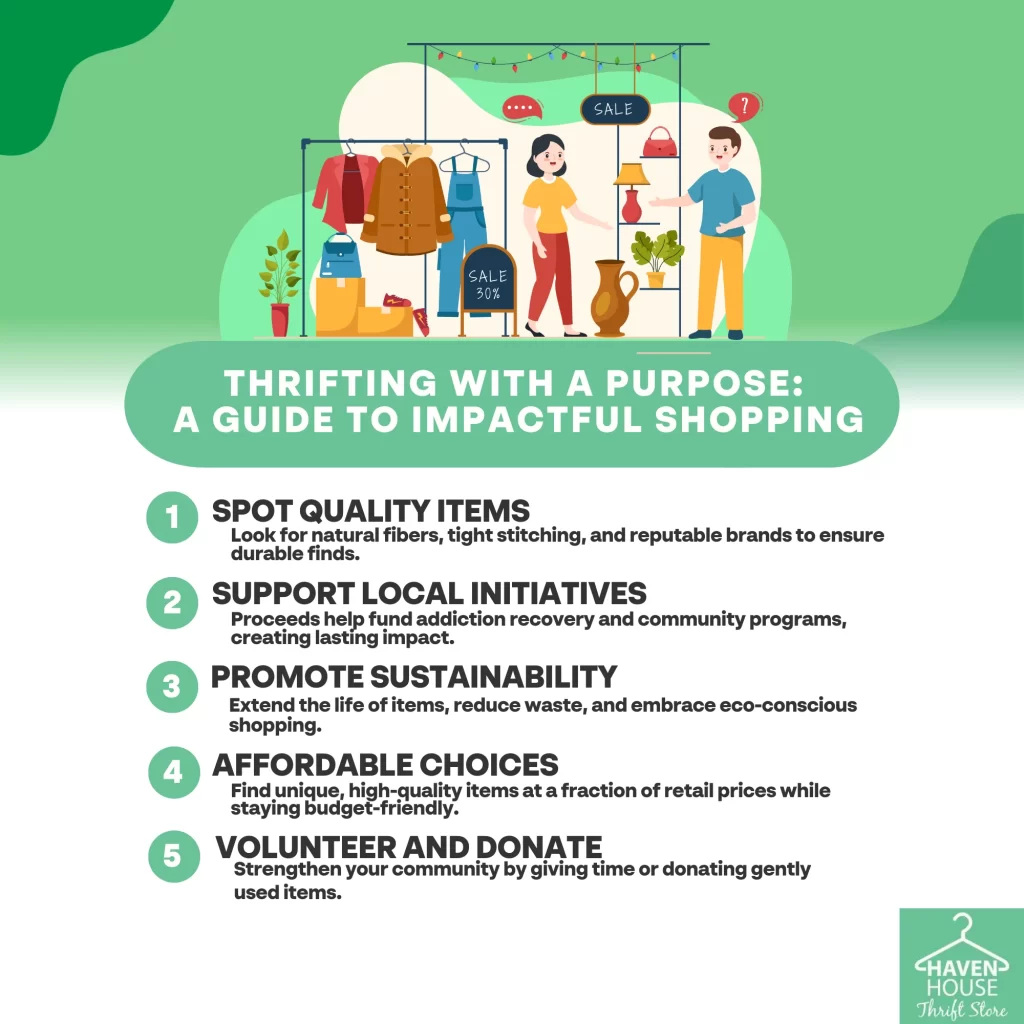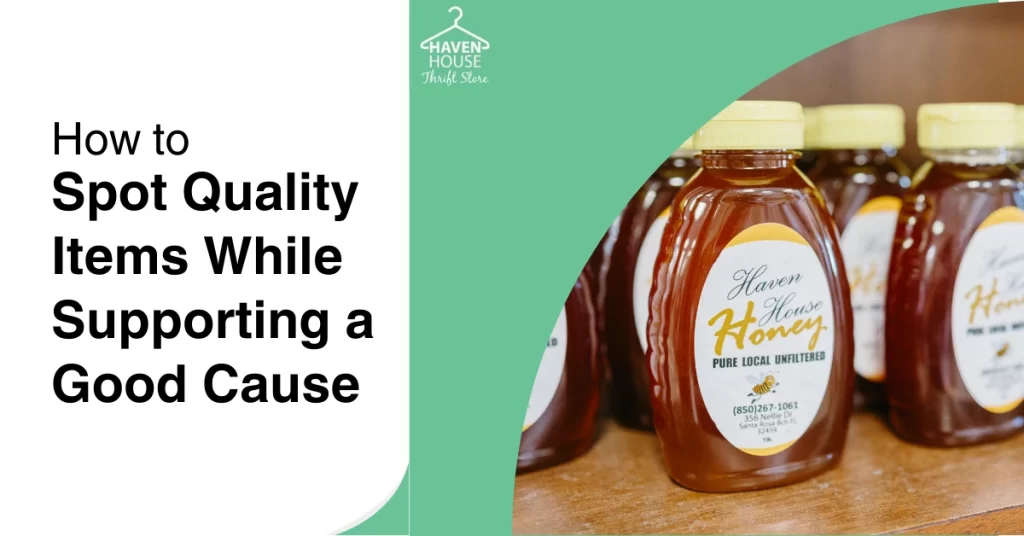When you’re thrifting for quality items while supporting a good cause, start by checking the materials. Natural fibers like cotton, wool, and silk often signify quality. Next, inspect the stitching; tight seams without loose threads are best. Don’t shy away from familiarizing yourself with brands known for craftsmanship. Then, evaluate the condition—look for minimal wear and functionality. Watch out for excessive damage or suspiciously low prices, as these can indicate poor quality. Trust your instincts; if something feels off, it probably is. There’s plenty more to discover about the thrifting experience and how to maximize it.

Key Takeaways
- Look for natural fibers like cotton, wool, and silk, which indicate higher quality and durability in clothing.
- Inspect stitching for tight, even seams and no loose threads, ensuring the item is well-crafted.
- Familiarize yourself with reputable brands known for quality craftsmanship to make informed purchasing decisions.
- Assess the overall condition of items for minimal wear, avoiding those with stains, rips, or missing parts.
- Trust your instincts; if an item feels off or questionable, it’s best to pass it up.
What is Thrifting and Why is it Popular?
Thrifting has become a popular trend among shoppers looking for unique items while supporting a good cause. As you explore thrift stores, you’re not just hunting for treasures; you’re also contributing to local charities and community initiatives. Knowing how to spot quality clothing can enhance your thrifting experience.
First, check the fabric. Natural fibers like cotton, wool, and silk often indicate durability and comfort.
Next, examine the stitching. Look for tight, even seams without loose threads. High-quality clothing typically features details like reinforced seams and lining.
Don’t forget to inspect the brand. Familiar names often signal better construction and materials, although lesser-known brands can surprise you with quality.
Pay attention to the condition, too. Look for minimal wear, stains, or damage. A well-cared-for piece can offer a longer life span.
Finally, trust your instincts; if something feels good when you try it on, it likely is.
Benefits of Shopping Second-Hand
Shopping second-hand offers a myriad of benefits that go beyond simply finding unique items. Foremost, it’s an affordable way to upgrade your wardrobe or home without breaking the bank. You’ll often find high-quality, gently used items at a fraction of their retail price.
Plus, you’re supporting local charities and community initiatives with every purchase, which adds a feel-good factor to your shopping experience.
Another advantage is the thrill of the hunt. When you visit thrift stores, you’re not just shopping; you’re exploring. You’ll develop skills on how to spot valuable items at thrift stores, learning to recognize quality brands, vintage pieces, and hidden gems that others might overlook.
Additionally, you’re contributing to a more sustainable economy by giving pre-loved items a second life. This helps reduce waste and promotes a culture of reusing and recycling.
Ultimately, shopping second-hand allows you to express your personal style while making a positive impact. Next time you’re in a thrift store, remember that every purchase supports a good cause, and your wallet will thank you too!
Thrifting for a Sustainable Lifestyle
Embracing a sustainable lifestyle is easier than you might think, especially when you explore the world of second-hand treasures.
Thrifting allows you to reduce waste, save money, and support community initiatives all at once. When you shop at thrift stores, you’re not just finding unique items; you’re playing a part in a more sustainable future.
To make the most of your thrifting experience, you’ll want to know how to check product quality.
Start by inspecting clothing for signs of wear, such as fraying seams or stains. Check for zippers and buttons to verify they function properly.
For furniture or home goods, look for sturdy construction and any visible damage. Don’t hesitate to test items; if it’s an electronic device, plug it in if possible.
Spotting High-Quality Items
When you step into a thrift store, the thrill of discovery awaits, but knowing how to spot high-quality items can make all the difference. Here are some tips to help you identify those hidden gems:
- Check the Material: Look for natural fibers like cotton, wool, or silk. They tend to be more durable and have a better feel than synthetic materials.
- Inspect the Stitching: Quality items often feature tight, even stitching without loose threads or fraying. This attention to detail indicates a well-made piece.
- Examine the Brand: Familiarize yourself with brands known for their quality. High-end labels often signal better craftsmanship and materials.
When you keep these pointers in mind, you’ll increase your chances of finding quality items that not only serve you well but also support a great cause.
Don’t hesitate to feel fabrics and check for signs of wear; it’s all part of the adventure. With a keen eye and a little patience, you’ll soon discover that thrift store shopping can yield fantastic treasures while making a positive impact on your community.
Happy thrifting!
Red Flags to Watch Out For
While hunting for high-quality items, it’s just as important to be aware of potential red flags that could indicate a poor purchase. First, check for excessive wear and tear. If you see significant stains, rips, or signs of damage, it’s best to move on. You want items that look like they’ve been cared for, not discarded.
Next, pay attention to the brand. While lesser-known brands can sometimes offer quality, be cautious of items from brands known for poor craftsmanship. Understanding how to spot quality items often involves recognizing trusted labels.
Additionally, be wary of items that seem too cheap. If the price is suspiciously low, it could signal low quality or hidden flaws. Remember, quality items often come with a price that reflects their durability.
Lastly, consider the item’s functionality. If it’s missing essential parts or doesn’t operate as intended, it isn’t worth your money.
Always trust your instincts; if something feels off, it probably is. By keeping an eye out for these red flags, you’ll be better equipped to make informed purchases that support a good cause.
Cleaning and Sanitizing Thrifted Items
Cleaning and sanitizing thrifted items is essential to guarantee they’re safe and ready for use. You never know where these items have been, so taking the time to clean them guarantees the quality of items you bring into your home.
Here’s how to get started:
- Clothing: Wash items in hot water with a strong detergent. For delicate fabrics, consider using a gentle cycle and air drying.
- Furniture: Wipe surfaces with a disinfectant spray or a vinegar-water solution. Don’t forget to vacuum upholstery and cushions.
- Housewares: Soak dishes, glasses, or utensils in a bleach-water solution. Rinse thoroughly and allow them to air dry.
Upcycling and Repurposing
Upcycling and repurposing thrifted items can breathe new life into forgotten treasures, making it an exciting way to showcase your creativity. When you’re out hunting for unique finds, keep an eye out for items that have potential.
A tired piece of furniture can become a stunning statement piece with a fresh coat of paint and new hardware. Look for vintage fabrics that can be transformed into throw pillows or curtains, adding a splash of color to your space.
To learn how to find good stuff in thrift stores, focus on quality materials. Solid wood furniture, durable fabrics, and items with good bones are often worth investing time into.
Don’t shy away from things that may need a little TLC; the challenge of transforming them can be incredibly rewarding.
Frequently Asked Questions
How Can I Support My Local Thrift Store Initiatives?
You can support your local thrift store initiatives by regularly shopping, donating gently used items, volunteering your time, and spreading the word about their mission. Every action contributes to their positive impact on the community.
What Types of Donations Are Most Needed at Thrift Stores?
Did you know that clothing donations makeup 60% of thrift store inventory? You can help by donating gently used clothes, household items, and furniture, ensuring your local store thrives while supporting community recovery programs.
Are Thrift Store Proceeds Tax-Deductible for Donors?
Yes, thrift store proceeds are often tax-deductible for donors. You should keep a record of your donations, as this documentation helps you claim deductions when filing your taxes, benefiting both you and the community.
How Do Thrift Stores Impact Addiction Recovery Programs?
Thrift stores profoundly impact addiction recovery programs by providing essential funding through sales. When you shop or donate, you’re directly supporting local initiatives that help individuals regain their lives, creating a positive community influence.
Can I Volunteer at My Local Thrift Store?
Yes, you can volunteer at your local thrift store! Just reach out to them directly, express your interest, and they’ll guide you through the process. Your help can make a real difference in the community.
Conclusion
By embracing thrifting, you’re not just uncovering hidden gems; you’re supporting essential community programs and promoting sustainability. As you explore each aisle, remember to look for quality, stay alert for red flags, and envision new possibilities for your finds. With every purchase, you’re making a positive impact, transforming lives, and nurturing our planet. So, immerse yourself in the thrill of thrifting, relish the adventure, and enjoy the satisfaction of shopping with purpose! How to find the best stuff at thrift stores? Keep your eyes peeled for sales or social media posts from your local store! Happy Shopping!

